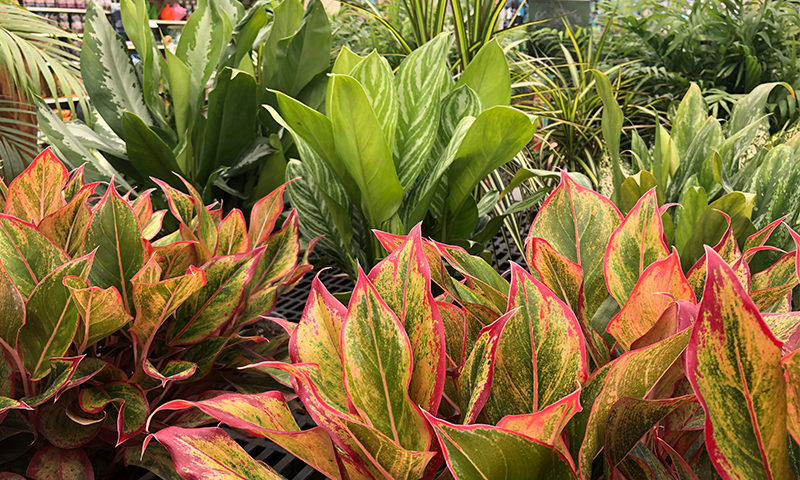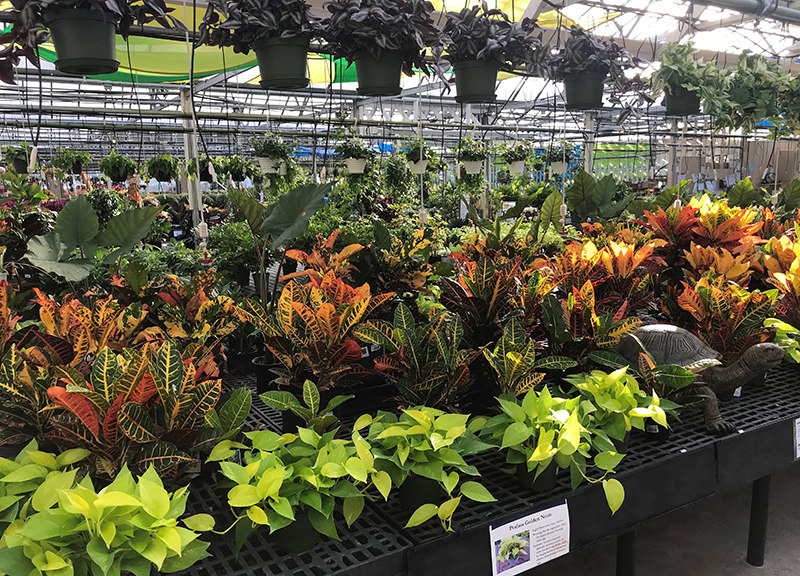Bring in Your Houseplants

Make Your Houseplants Happy
Though your houseplants have enjoyed beautiful days outside on your porch or patio for many months, now is the time to consider bringing them inside for the Winter! The first frost shows its face in Fall, which means tender houseplants need to retreat indoors for the rest of the year. Our current season typically presents some unpredictable weather patterns, so to play it safe we recommend taking your plants inside as soon as possible. After all, you wouldn’t want your beloved houseplants to freeze, right?
While it sounds like just a simple transport from outdoors to indoors, we advise that you follow a few steps when bringing your houseplants inside. Always check for bugs that may want to feed on your plants. Some bugs that make it inside during the transport could retreat back to the outdoors, however others act like parasites and overstay their welcome. Simply follow our steps for properly transporting your houseplants and you will ensure that they remain happy and healthy!
Transporting Your Houseplants Indoors
#1 – Tidy Up the House
First, because your plants will shift to a new setting, it is important that you provide them with a pleasant atmosphere in which they can appropriately adjust. Make their transition as smooth as possible by preparing your area indoors for them.
- Clean your windows inside and out to provide optimal, natural lighting.
- Do a thorough dusting in the rooms where you plan to house your plants.
- Install any hardware that you may need to host your plants. Hang ceiling hooks and shelving, or simply clear space for them on existing mantles, tables, or the floor.
#2 – Slowly but Surely
Next, as to not totally shock your houseplants, begin bringing your plants inside when the evening temperatures start to dip. Remember, your plants must come indoors before nighttime temperatures fall below 45 degrees Fahrenheit. These colder temperatures inflict damage to tropical plants especially. Before you bring them in, inspect for insects and use a damp cloth to wipe the leaves off. You can also run your houseplants quickly under your garden hose to shake off some of the more persistent bugs. You may find aphids, mealybugs, or spider mites, all of which should not be allowed to follow your plant inside.
Light and humidity changes drastically differ from outside to inside, so the best time to start acclimating your houseplants indoors is at night. Start by bringing your containers indoors overnight and moving them back outdoors in the morning time. Over the course of several weeks, gradually increase the amount of time they spend indoors.
#3 – Repotting
Before you treat your houseplants for possible insects, determine whether you need to repot them. Look at their size – if the plant seems to be too large for its pot or if it requires more water than usual, it’s time to repot. Increase the pot size by 1-2 inches in overall diameter when you repot as to not go overboard. Follow these steps carefully when repotting:
First:
- Water your plant several hours (up to 1 day) before it is time to repot so that it becomes slightly moist.
- When removing it from its old pot, support the plant by placing your hand over the top of the soil with the stem between your fingers.
- Tip the pot upside down and slide the root ball out of the pot. You may need to tap the rim of the pot gently with a knife or other tool. (If the plant still will not budge, slide the blade of a knife between the outside of the soil and the inside of the pit, then slide the plant (roots, soil, and all) out of the pot.)
- Cover the drainage hole of the new pot with a piece of plastic, newspaper, or a coffee filter that has been cut to fit the bottom of the pot. This will prevent the soil from washing out of the hole when you water. It will also keep out insects.
Second:
- Wet the growing medium before using it, preferably a day in advance. Place an inch or so of fresh soil in the bottom of the pot and firm it into place.
- Set the plant back in the pot to check the depth. You want to leave an inch of space from the rim to the top of the soil to allow for watering.
- Add or remove soil from the bottom of the pot, as necessary, to achieve the proper height. (Never pile soil up around the stems at the base of the plant.) Keep the plant at the same level as it was in the original pot.
- Gently disturb the root system with your fingers so that the roots are headed outward from the root ball. If the roots are very tight and compact in the pot, and you cannot pull them apart, score the root ball with a knife to loosen them. If roots are wound around the bottom of the root ball, pull them apart and cut off excessive amounts.
Third:
- Place the root ball in the pot and fill in around the sides of the ball with potting soil. Tap in the new soil gently as you go, until you reach the top of the root ball. press your fingers gently into the top of the soil and tap the pot several times on the tabletop to settle the contents. Add more soil if necessary.
- Water the plant to settle the roots in place by immersing the entire pot in a bucket of water or a sink for 30 minutes to 1 hour. If you use a watering can, run water through the drainage hole at least 3 times. This is done only when transplanting and when the plant has been allowed to completely dry out.
- Never allow the plant to sit in water. Remove the standing water from the saucer after watering, or fill the saucer with gravel so that the plant sits up out of the water.
Tip: When repotting a bigger plant into an ever bigger pot, it may be a good idea to use an alternative to soil to fill your pot. You can use packing peanuts, old plastic bottles, or even an old plastic pot to help fill the space on the bottom. This helps keep the pot lighter if it needs to move, it adds drainage, and also uses less soil. These fillers should take up 1/3 of the pot. Get creative with it!

#4 – Treat Your Soil and Plant
Once you are ready to fully bring your plants indoors, apply Systemic Houseplant Granules to the soil. This gives your houseplants long-lasting defense against tough insects that might develop later from eggs. Please note that the granules do take some time to set in and start getting the job done.
Next, treat your plant with an Eight® Insect Control RTU by Bonide. This destroys adult insects as well as apparent eggs, providing your plants with fast-acting protection in advance of when the granules finally start working.
#5 – Bring Them In!
Finally, after you have repotted and treated, you may enjoy your houseplants right from the comfort of your home. Bring them inside and nurture them as best you can. Like humans take some time to adjust to new surroundings, so too will your houseplants, so expect to notice a few leaves dropping at first. This is completely normal. New leaves should form as your plants adapt to their new home.
Here are some additional tips to know when acclimating your houseplants to the great indoors:
- Consider taking some cuttings off your annuals when repotting, such as begonias, impatiens, geraniums, and coleus.
- Always be sure to not overwater. Check that the soil feels dry to the touch before watering again. Water cacti and succulents when the soil feels dry for several days.
- Plants need far less water when indoors than they do when they are outdoors.
- If you are concerned whether you are not watering enough or if you might be overwatering, consider purchasing a moisture meter. Easy to read, they detect moisture deeper down in the pot than our fingers can. Find them in our stores.
- Apply a fertilizer boost to your houseplants according to the directions on the label.
- If you notice insects anytime over the Winter, consult our in-store experts for additional tips on how to take care of eliminating them.
If you have any additional questions, please feel free to ask our team. We are always ready to help!
Our Home & Garden Stores have an excellent selection of indoor plants in all shapes, sizes, and colors. Visit our stores today and liven up your home with gorgeous houseplants!
Learn more about the best houseplants for every room.
